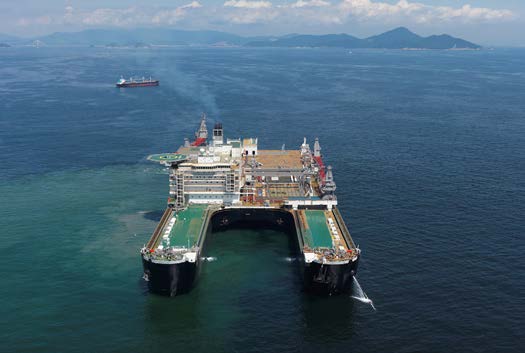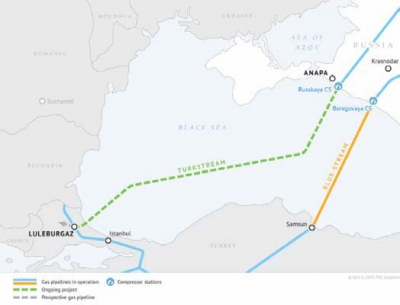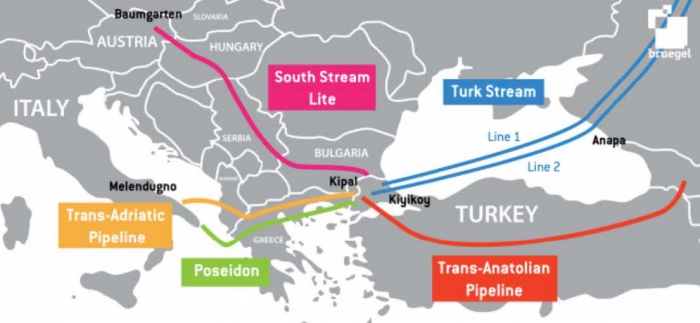[NGW Magazine] TurkStream 2 seeks routes into Europe
As the work on laying the second string of Gazprom's TurkStream line resumes, the relations between the Balkan countries, the gas exporter, the pipeline investors and their regulators in Brussels could become more politically charged.
The Allseas Pioneering Spirit vessel (formerly known as Pieter Schelde, Figure 1) returned to the Black Sea in late June and resumed pipelaying for TurkStream’s second string, following completion of the first string in April this year.
Figure 1: Pioneering Spirit

Credit: Allseas
It should be remembered that a 224-km section of this second string, up to the Russia-Turkey exclusive economic zone boundary, had already been installed in 2017. The offshore section of each pipeline is 900 km long, in up to 2,200m water depth.
Similarly to the first string, the second line, TurkStream 2 (Figure 2), will have 15.75bn m³/yr capacity. But unlike the first, this is intended to carry Russian natural gas to European markets. Gazprom announced earlier this year that Greece and Bulgaria are both possible route options for the pipeline after it leaves Turkey.
Figure 2: TurkStream gas pipeline

Source: Gazprom
TurkStream
TurkStream is a new export gas pipeline, with two strings stretching from Russia to Turkey across the Black Sea. The first string of the pipeline is already in place and it is intended to replace gas to Turkey through Ukraine when it becomes operational in 2019. The second is intended to supply gas to southeast and central Europe, and also partially replace gas flows from the Ukraine route.
A third pipeline, Nord Stream 2, to reach Germany through the Baltic Sea, is being constructed for the same purpose. But these pipelines face opposition mostly from eastern European countries, but also from the US, for various reasons, including their economic impact on Ukraine. However, so far the construction of all projects is proceeding on target.
The founder of Oxford Institute of Energy Studies (OIES) Natural Gas Research Programme Jonathan Stern, said in February that the European sections of TurkStream 2 and Nord Stream 2 can be realised with an understanding from the European Commission (EC) to include a deal on Ukraine. He said: "The EC will want some kind of concession from Gazprom on a related issue, perhaps on the Nord Stream 2, or perhaps on Ukraine. But the key thing for TurkStream’s second line is that the gas may need to reach EU countries through other pipelines. If TAP is not fully utilised, then some Russian gas could go through TAP… There are lots of different options but this cannot be done except with an understanding with the EC, which I think will have to include an understanding on Ukraine."
This could involve Gazprom continuing to send a minimum amount of gas through Ukraine. However, Gazprom’s position is that both pipelines are compliant with EU regulations.
TurkStream replaces South Stream, a pipeline first proposed by Gazprom in 2007 to transport gas through the Black Sea to Bulgaria and from there to Austria through Serbia and Hungary. Following controversy owing to non-compliance with EC competition law on tendering for pipelines, Gazprom cancelled South Stream in 2014 with the announcement of the TurkStream pipeline. However according to an industry source, the second TurkStream line will go directly to Bulgaria, contradicting the official position.
Both TurkStream 1 and 2 are expected to start operating in 2019. This was confirmed by Gazprom CEO Alexei Miller July 2. He said: “Today, we received a permit to lay the second string in the exclusive economic zone and territorial waters of Turkey. We now have all of the required permits from the Turkish government to lay the TurkStream gas pipeline in the offshore area. It is therefore a certainty that both strings of the gas pipeline will be put into operation right on time, before the end of 2019.”
Gazprom has confirmed that its intention is to deliver Russian gas to consumers in Europe through Greece and Bulgaria, but owing to EU regulations on unbundling supply from transport, it cannot operate the pipeline inside the EU. As a result, it has been exploring potential alternative options with European gas grid operators to deliver TurkStream 2 gas to Europe. The chosen routes will probably be made clear next year, given the end of 2019 target to start operating the pipeline.
Gas to Europe – route choices
Unlike South Stream, the EC cannot block the second string of TurkStream, because it is not arriving in a EU-member country but in Turkey.
Former Botas CEO Gokhan Yardim said in June at a conference in Thessaloniki that TurkStream 2 “could be connected to the existing pipeline interconnecting Turkey and Greece. This is operating at a low 6bn m³/yr capacity, but the designed capacity is 10bn m³/yr. So there is capacity in the existing pipeline that can be used.”
He also said that Gazprom is investigating the possibility of using the Interconnector Turkey-Greece-Italy (ITGI), also known as the Poseidon pipeline, which lost the race for Azeri gas to the Trans Adriatic Pipeline (TAP). He added: “My feeling is that some of the gas will go to Greece and some will go to Bulgaria. But what’s important is the interconnecting lines.” (Figure 3)
Figure 3: Pipeline options to extend TurkStream 2 to Europe

Credit: Bruegel
There is also the option to use TAP. Even though its current capacity is 10bn m³/yr, it can be expanded to 20bn m³/yr by adding compressor stations. In accordance to EU’s internal gas market rules this additional capacity would be open to third-party access.
Gazprom would have the right to bid for and use this capacity. But this would of course defeat the original purpose of the pipeline, which was to deliver non-Russian gas to Europe. However, should Gazprom decide to proceed with this, it will be difficult to stop.
A route through Bulgaria could link to Austria’s Baumgarten gas hub through Serbia and Hungary, by following the original route of the cancelled South Stream. This was confirmed in January by Alexander Medvedev, deputy chairman of Gazprom’s management committee, when he said that Gazprom is considering various options to bring natural gas to Europe through TurkStream's second string, including using Austria's Baumgarten gas hub. The hub receives about 40bn m³/yr gas for redistribution in Europe.
Medvedev noted that in accordance with Gazprom's forecast, conservatively, Europe would need an additional 50bn m³/yr of natural gas by 2025, and 75bn m³/yr by 2035. He also asserted that both TurkStream 2 and Nord Stream 2 were fully in compliance with European regulations. However the EC has been criticised for trying to change the rules to make it harder for Gazprom to build NS2, although TurkStream remains outside EU territory.
Greek Stream
A possible route to take TurkStream gas to Europe is through Greece, led among others by Italian companies Eni and Snam.
The idea of Greek Stream first appeared in September last year, following the Greek-Italian Cooperation Council ‘first bilateral intergovernmental conference’ in Corfu. This was concluded with a joint declaration, signed by Greece’s energy minister, Giorgos Stathakis, and Italy’s minister of economic development, Carlo Calenda. That statement made a specific reference to the “development of a new diversified route for the transport of Russian gas through the IGI Poseidon pipeline and the extensions of the natural gas transmission systems of Greece and Italy”, dubbed by the Greeks as the ‘Greek Stream’.
Italy has been promoting IGI Poseidon intensively since 2017 as it sees it as vital for its energy efficiency. The argument made repeatedly by Italy to the EC and others is that TurkStream and IGI Poseidon will not increase Russian gas presence in Europe. Its purpose is simply to replace the Russian gas route to Italy from the north with a more economical southern route.
The need for economical, secure, gas supplies in the longer term is identified in Italy’s Energy Strategy to 2030 (NGW, Vol 2/13, July 3, 2017).
The latest in a series of meetings in support of this route took place in Moscow in April between Snam CEO Marco Alvera and Alexei Miller. They noted that Europe needs new and reliable routes for gas imports amid declining indigenous production.
Snam is the majority shareholder of a consortium that in April acquired a 66% stake in Desfa, the Greek gas infrastructure operator. Snam’s share is 60%, with Enagas and Fluxys each holding 20%. The same companies are also shareholders of TAP. In addition to commercial factors, their interest in Greece, and gas pipelines through Greece, is that it represents an important crossroads for the diversification of supplies and the opening of new natural gas routes in Europe. Hence its interest in Greek Stream.
Eni and Edison were also in discussions with Gazprom in 2017 about the possibility of importing gas from a southern route, as an extension of Turk Stream. In fact in March 2017, Gazprom and Eni signed a memorandum of understanding to develop the southern corridor for gas supplies to European countries, including Italy.
Later, at a meeting with Russia’s energy minister Alexander Novak in June 2017, Calenda confirmed that Italy and Russia were working closely together for energy security. He said: "We feel it is important to have South Stream which you know was somehow halted, but which should be re-launched soon."
In addition, in June 2017 Miller, Edison CEO Marc Benayoun and Depa CEO Theodoros Kitsakos signed a co-operation agreement at the St Petersburg International Economic Forum, in the presence of Calenda. Kitsakos is also chairman of IGI Poseidon.
The agreement envisages undertaking joint efforts to establish a southern route for Russian gas supplies to Europe, through Turkey, Greece and Italy. The companies agreed to co-ordinate the development of a pipeline project, including IGI Poseidon, from the Turkish/Greek border to Italy. Quite important, it states that this will be done in full compliance with relevant applicable legislative frameworks.
This was further confirmed by Novak in August 2017. He said that Russia is ready to supply gas through the TurkStream pipeline to Greece and Bulgaria. He added: "We are constantly discussing these issues with countries interested in receiving Russian gas such as Greece and Italy. Bulgaria is now again part of the initiative to make supplies through its territory." In fact, Bulgaria confirmed its readiness to receive gas from TurkStream in July 2017. Hungary also signed an accord with Gazprom in July 2017 to link into TurkStream.
Italy’s interest was reconfirmed as recently as March this year at a working meeting between Miller and Italy’s ambassador to Russia, Pasquale Terracciano. They discussed the status and prospects of bilateral co-operation and ongoing efforts to create a southern route for Russian gas supplies to Europe, with particular attention paid to the diversification of gas export routes from Russia to Italy and Europe.
Italy hopes that natural gas will be provided by TurkStream, extending through Greece, and IGI Poseidon. Italian officials have often made the case in Brussels as well as in Washington – both are watching these developments with interest. In fact, Italy believes it has the tacit approval of the EC, but this is still to be seen. In addition to its sanctions against Russia, the US is still applying pressure against TurkStream 2. The European view, though, appears to be that US sanctions may make it harder for Russia to build gas export pipelines to Europe but it is unlikely to stop them.
But Gazprom is not taking any chances. It has been taking steps to reduce any potential risk, by proceeding with the construction of TurkStream 2, even before routes to take its gas to Europe have been agreed, just in case any new sanctions hit it. But it may also be that Gazprom now believes that any obstacles to TurkStream 2 gas reaching Europe have been largely overcome.
However, the fly in the ointment may be Italy’s new government. In June the country’s new environment minister, Sergio Costa, placed the TAP gas pipeline project under review. He said: “Given our energy policy and given falling gas demand, that project today looks pointless.” He was referring to the new government’s shift towards green energy. This was confirmed by the minister for southern Italy, Barbara Lezzi, who said the pipeline represents an unnecessary environmental danger given Italy’s excess gas capacity.
It is not yet clear whether these comments will lead to any action but the new Italian government appears to be in favour of an opening toward Russia. As a result, it is not clear how it will respond to Greek Stream taking Russian gas to Italy and from there into Europe. Previous Italian governments pushed for TurkStream 2 on economic grounds, to replace gas that is being delivered to the country through the more expensive north route. This may still prove to be a valid reason to continue supporting this project.
Given that all pipelines and interconnectors under consideration, once TurkStream 2 gas leaves the Turkey/Greek border, will be owned and operated by different European companies, Greek Stream may indeed be in full compliance with EU regulations and TEP. It all looks like a game of chess with intriguing moves but no end-game yet. But whatever happens to the Greek Stream option, the possibility of linking TurkStream to Europe through a Bulgarian route also looks likely.
Balkan Stream
Ever since the demise of the South Stream pipeline, Bulgaria has been canvassing for TurkStream gas to be piped to southeast and central Europe across its territory.
Bulgarian gas grid operator Bulgartransgaz announced a new 10-year investment plan early July. In terms of new infrastructure, this includes reverse flow gas interconnectors with neighbouring Serbia, Greece and Turkey, as well as the development of a ‘Balkan gas hub’ in Bulgaria. This envisages the construction of an EC-funded regional gas distribution centre near Varna to distribute gas to countries in the Balkans and central and western Europe. However, in order to approve the gas hub, the EC has stipulated that Bulgaria needs to become a gas trader, not merely serve as a gas transit country, by securing at least three different sources of natural gas supplies for the potential Balkan gas hub. Bulgartransgaz new proposed infrastructure may just do that.
Bulgaria and Serbia signed a joint declaration in May for the construction of an interconnector to link their gas transmission systems by May 2020. EIB confirmed in May that it intends to support this by providing financing up to €30mn. This followed an announcement in March by Serbian gas company Gastrans saying it aims to start operating a natural gas pipeline that will connect Bulgaria and Hungary through Serbia by October 2019 and published a non-binding tender for capacity booking.
In June Hungary's foreign minister, Peter Szijjarto, added his voice to this when he confirmed that Hungary hopes to start imports of Russian natural gas through Bulgaria and Serbia, using Bulgaria’s notional link to TurkStream. He went on to say: "The new route would be a huge contribution to the safe and secure energy supply to our region and we hope that we will have the support of the EU.” Underpinning these developments are agreements Gazprom signed in 2017 with Serbia, Hungary and Bulgaria on developing their infrastructure and upgrading cross-border capacity to allow the onward flow to the region of gas delivered to Turkey.
The final link in this jigsaw puzzle is Austria. During his visit there in June, Putin confirmed: “Austria has become a major hub for gas transfer from Russia to Europe.” Responding, the Austrian chancellor, Sebastian Kurz, said: “Our relations are traditionally good. We co-operate well not only in the political but also in the economic sphere. This year we will celebrate the 50th anniversary of the supply of Russian gas. Co-operation between Gazprom and OMV is a co-operation that has always continued, despite difficult situations.” This confirms that this link is not expected to meet any challenges.
Based on these developments, Miller said early July that Gazprom may start exports of natural gas to Bulgaria, Serbia and Hungary in 2020, when TurkStream is expected to reach its projected capacity.
These projects, if realised, would provide a route from Turkey through the Balkans and southeastern Europe, the Balkan Stream. This could carry Russian gas from TurkStream to central Europe. More importantly, all planned links and interconnectors will be owned and operated by different European companies, with Gazprom’s direct gas transmission involvement stopping at TurkStream’s delivery point inside Turkey. Thus Balkan Stream could indeed be in full compliance with EU regulations and TEP, as Medvedev confirmed in January.
Charles Ellinas



